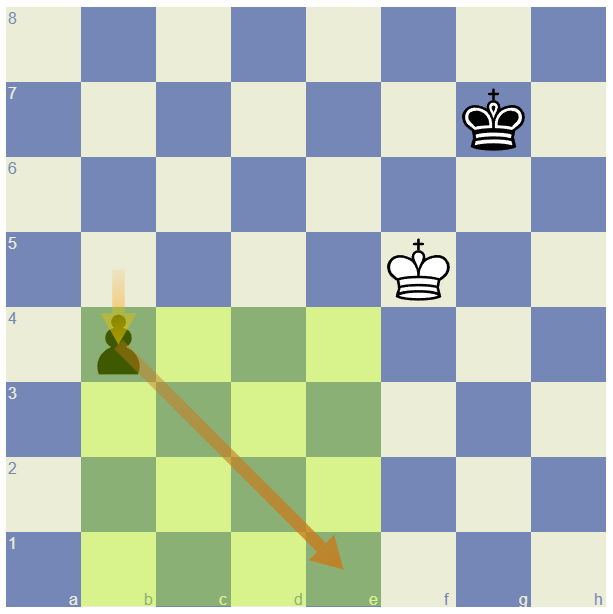The king is not in the square
Master this and many more motifs
systematically with
Puzzle Academy
Explanation
In these two levels, we are going to look at the important endgame king and pawn versus king. This endgame occurs in many games, and it is important to master it. Here we look at the situation, where the pawn is not assisted by its own king, and is advancing on its own to the promotion square. The question then is if the opponent's king is able to stop the pawn in time or not.
Instead of calculating this move by move, the rule of the square can help you to determine the outcome quickly. Imagine a square, with one edge drawn from the pawn to the promotion square, and then from the promotion square in the direction of the opponent's king.
The rule of the square says: When it is the opponent's move, and the king can reach the square, it is a draw. Otherwise the pawn can promote.
Hints

It can be easier to imagine the square by "drawing" a diagonal from the pawn in the direction of the 8th rank and the opponent's king, as illustrated here.
Remember that the pawn can move two squares if it is still on the initial square. In that case you must compensate by imagining the square as if the pawn had already moved one square ahead.
The two levels
In the first level, the king cannot reach the square, and the pawn is able to promote. In the second level, the king can reach the square and is able to stop the pawn.
Examples
Imagine the square with the corners b4, b1, e1, and e4.
The only way for the white king to reach the square is 1.Ke4!.
White can then stop the pawn, for example:
1...b3 2.Kd3 b2 3.Kc2 c1=Q+ 4.Kxc1 draw.
Imagine the move 1...a4, and then the square with the corners a4, a1, d1, and d4. White is not able to reach the square with the king, hence 1...a4! is winning. For example 2.Ke3 a3 3.Kd3 a2 4.Kc2 a1=Q.
Examples with the pawn on the initial square
Most puzzles in these two levels should be straight forward, but if the pawn is on the 2nd rank it can be a bit more tricky. This situation is illustrated by the following examples:
It looks as if the white king is inside the square. However, the pawn f7 is on its initial square, and Black can win by making use of the double-step 1...f5!. The pawn has escaped the square, and Black is winning.
Black has to be careful, because the pawn on g2 is on its initial square. 1...Kf2? would lose, because it would allow the double-step 2.g4! and the king can no longer reach the square. Instead, Black must take the long way with 1...Kf4! to ensure the draw.
Again the pawn being on its initial square makes it more difficult to achieve the draw.
1...Kf3? would allow 2.Kg5!, followed by the h4 double step, and the king
on g5 would block the black king from entering the square.
Instead 1...Kf4! is the only way to draw the game, ensuring that the king can access the g4 square on the next move.
Related motifs
The rule of the square can also be applied in some king and pawn endgames with more pawns, for example if the other pawns are blocked. In that case, first make sure that any other moves are irrelevant, before you apply the rule of the square.
You can learn about other cases of the endgame king and pawn versus king in the "Endgames" course.